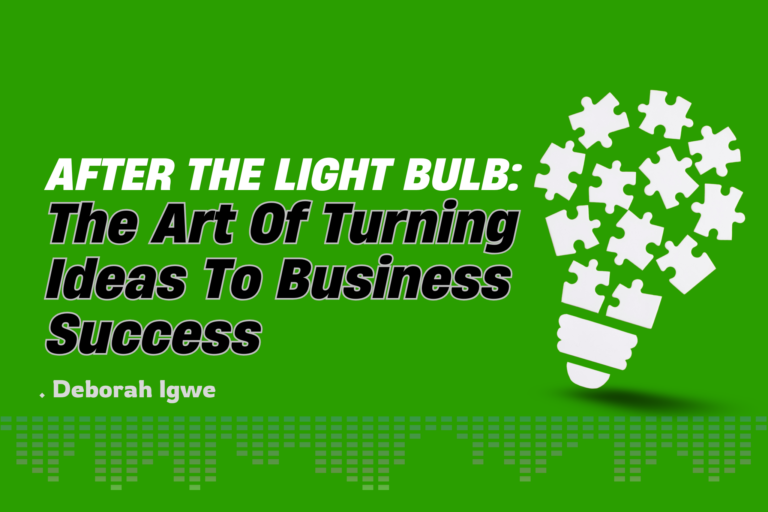The light bulb moment—when a powerful idea strikes—is arguably one of the most exhilarating experiences for any entrepreneur. It makes you feel like a sage, or perhaps a knight in shining armor, with an imaginary hero’s cape fluttering behind you, ready to embark on a mission to save the world. Ideas are powerful. Ideas are extraordinary. As a wise man once said, “Ideas run the world.”
Another beautiful truth is that ambition and the drive to take action are among the most admirable traits of entrepreneurs. Many people have ideas, but only a daring few bring them to life. Entrepreneurs are the bold risk-takers willing to bet it all to make their ideas a reality. They run the show.
Sadly, like some hero’s story, not all journeys end in triumph. Many entrepreneurs hope for a happy ending but are met with harsh realities. They take risks, expecting great returns, only to end up risking everything. Research shows that 45% of businesses fail within the first year, and 75% never make it past 15 years. Where do they go wrong? Or Are the “villains” of their own business story just too powerful?
The Art Of Turning Ideas To Business Success
Let’s go back to the beginning. After the light bulb moment of a new idea—what happens next? What transforms a spark-filled idea into something valuable? The answer is simple, yet overlooked: the value of an idea is determined by the people it was created for.
Value is not in the idea itself, but in how relevant it is to the customer. Customers are the lifeblood of every business, and the secret to building something sustainable is obsession with your customers. Too often, entrepreneurs become fixated on their solutions and forget the real hero’s purpose: solving the customer’s problem. No problem, no hero.
So, who are your customers? What problems are you solving for them? And what evidence do you have that these problems even exist?
The saying, “Customers are king,” isn’t a myth—it’s reality. Without customers, your business doesn’t exist. Every idea is hypothetical until validated by your target audience. The first step after receiving an idea is talking to your customers—understanding their pain points and gathering evidence that their problem is real.
Validating Your Idea through Market Research
Validation starts with market research. Here’s how to do it effectively:
- Know and Define Your Target Customers:
Clarity about your audience helps refine your idea to meet their specific needs. - Understand the Problem You’re Solving:
People value solutions only when their need is clear. Your role is to uncover and address these needs. - Talk to Your Customers:
Imagine your business as a courtroom. You wouldn’t pass judgment without hearing from witnesses. Customers are your witnesses—don’t validate an idea until you’ve talked to them.- Online research is helpful but not sufficient.
- Interviews, surveys, phone calls, and face-to-face conversations will reveal invaluable insights you can’t get elsewhere.
- You’ll be surprised by what customers share when you ask thoughtful, open-ended questions.
- Don’t Build First:
Your ambition might tempt you to start building before seeking feedback. Resist it. Building prematurely can waste time, money, and effort. - Focus on the Problem, Not the Solution:
The goal of customer conversations isn’t to sell your product—it’s to learn. Ask questions about the problem you think they face and let the insights guide you. - Eliminate Biases and Stay Open-Minded:
The solution you’re offering may not match the customer’s real needs—and that’s okay. A bad idea is better than a failed business. Stay open to refining or pivoting your idea. - Be Ready to Take Action:
Insights from customers should drive action. Refine your idea, adjust your target audience, or merge concepts to improve your offering. Knowledge gained will help you build better and engage more effectively. - Prepare for Setbacks:
Validating your idea can be slow, tedious, and challenging. But remember, it’s better to lay a solid foundation than rush onto shaky ground. - Seek Professional Help:
If possible, outsource market research or work with a business development professional. They’ll guide you through a structured process, saving time and ensuring you gather the right insights.
Some entrepreneurs romanticize failure, believing that endless trial and error makes for a heroic comeback story. But let’s face it: wasted time, burned funds, and unrecoverable setbacks are costly—and not everyone gets a second chance.
Entrepreneurship will always involve risk, but it doesn’t have to be blind. Make it a calculated risk. The next time you get that light bulb moment and reach for your hero’s cape, remember: the real hero puts customers first.
Talk to them. Understand them. Solve for them. Because without a problem to solve, there is no hero to save the day.


